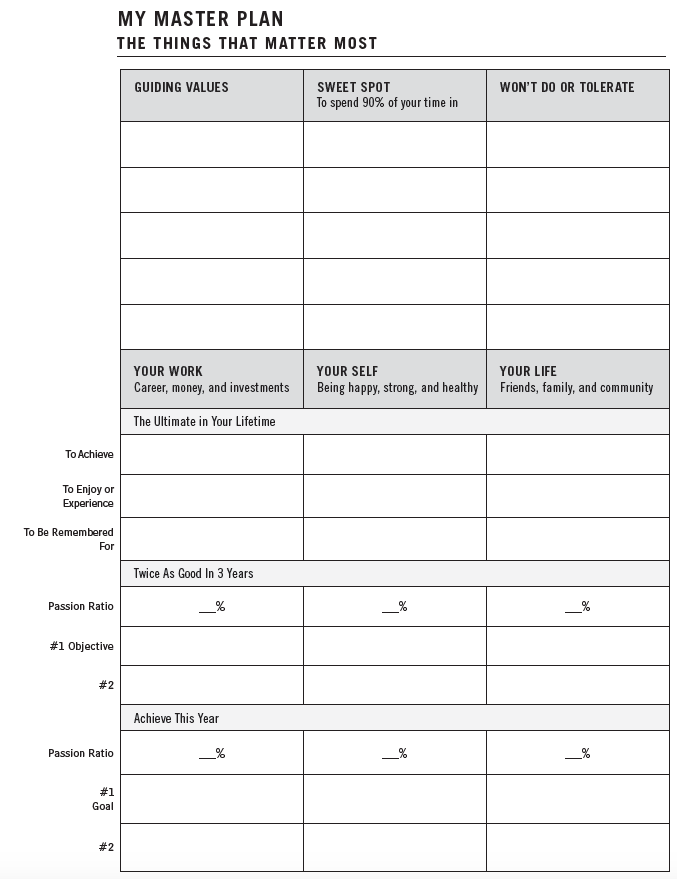Work Life Planning: Plan, Plan & Plan Again
We have goals of where we want to get to, and great plans. But of course, that’s not how it happens. We end up here, there, and everywhere, when all we need to do is continually recalibrate once every quarter, and we’ll get to our goals.
The question is, “How disciplined are you about planning and regularly re-planning for your work, self, and life in terms of what you want to achieve?”
Most people in business have clear goals and objectives in their company. If you don’t, maybe you should start with that!
But where we often fail is in our plans for yourself and our life. And that’s why I created the master plan. Even when you do have a great plan, sometimes things go sideways.
“Everyone has a plan till they get punched in the mouth.” – Mike Tyson
You can be going along when life throws you a curve ball – and you’ve got to reset or rethink your plans. That’s why you can start with a plan but every quarter, you have to refocus.
Key Point – You’ve got to have a simple, all-encompassing plan – ideally on one page. And, in this case, the master plan for your work, yourself, and your life.
You know you need to work on this if:
- Logic just tells you, you should. And you should have an integrated plan that pulls it all together
- You have elaborate, long-winded plans, but don’t reference them very often
- You don’t consistently achieve the goals you envision
- You get sidetracked by sudden inspirations
- You consistently over-achieve in one area (likely at work), but under-achieve or sacrifice too much in terms of self and life.
Work Life Planning Tool
Here is the master plan tool. It is extremely simple yet integrates everything that matters to you in one spot, and allows you to recalibrate.
At the end of the year, you do the annual review (see the download link at the bottom of the post to access all the worksheets) where you answer questions about the three categories of your life: work, self, and life and how things went, with some ideas on what might make this year better.
Then you switch over to the master plan and reset your plan for your life:

Across the top, you’ll find three things:
- Your guiding values. If you’ve thought about core values and values you live by, those go there.
- Your sweet spot (which we talked about earlier in the book) is the place where you absolutely thrive and do your best work.
- The things that you won’t do or tolerate. This taps back into the principles of teaching people how to meet your standards.
So those are overarching principles.
Then you get into three different time frames.
- The ultimate in your lifetime
- What you want to achieve to be twice as good in the next three to five years, and
- The next year.
It’s super important that you get this sorted. It’s also a great activity to do with your family members or people close to you, to make sure you’re all aligned around what matters for your family.
The key with this master plan is to take into account work, self, and life, and to make sure that you always do the things you need to do for yourself, because you’re the thing that holds it all together. You’re the glue, you’re the structure – and if you don’t get what you need for yourself, the rest is going to fall apart.
Then there’s the quarterly reset. Every 90 days, go back and do the page where you reflect on the quarter. “Hey, how did it go? What would make it better in each of those three categories work, self, and life?” And then you have a new plan for the quarter. “How much passion do I want to allocate to work, self, and life? What’s my number one goal in each of those areas?”
If you dare be so bold…
- You might have your second and third goal in each area and then
- Take a look at the toads that might be building up – the habit that you want to start (likely one of the habits out of the book) – and what you want to stop.
And then there’s room for the action plan, to do what you need to do to move forward.
These tools are actually quite simple. It’s a matter of making the time, and making it a priority to go and sit, to look at what really matters in those three areas and make sure that when you look at your master plan at the end of your life, you’re not going to say, “Woulda, coulda, shoulda.” You’re going to say, “Been there, done that, and I’m thrilled with how I lived.”
On a quarterly basis, it’s the same thing. It’s about being clear that if this is what I accomplish this quarter – forgetting everything else that may or may not happen – I’m going to feel very good about how I’ve lived my life, in every aspect of life.
The Challenge
- Download and draft your master plan, and your plan for the next quarter.
- Spend some time, think about them.
- Run them by a friend, run them by a family member, and make sure that they make sense.
At the end of the day, the most important things should be on your plan. And don’t worry, all the other random things will continue to show up. But you need to stay focused on the biggest opportunities to make your life great, your work great, and for you to feel great about who you are.
Keep growing. Keep learning. Keep driving.